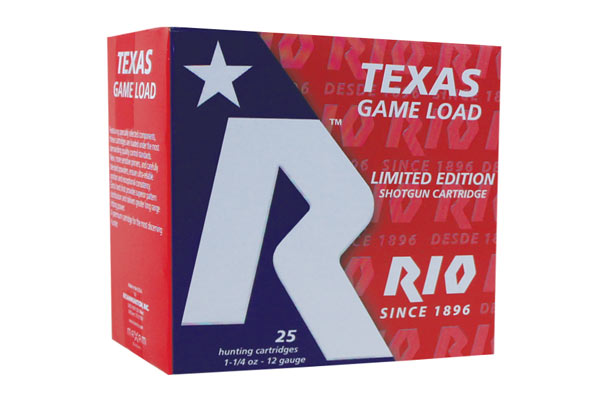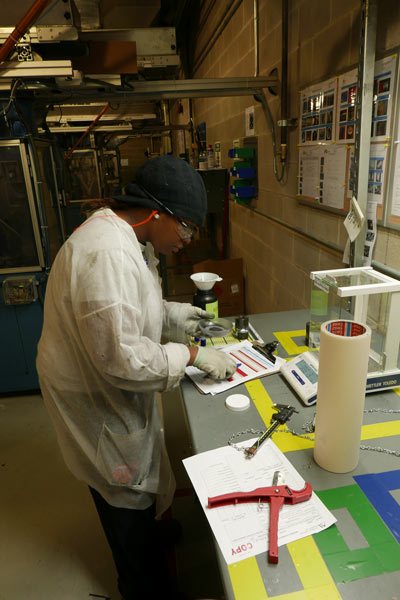July 15, 2015
By John Taylor
 The familiar clickety-clack of loaders turning out boxes of shotgun shells in mere seconds is a familiar sound in an ammo plant. But they sounded distant in Rio's huge new facility in Marshall, Texas.
The familiar clickety-clack of loaders turning out boxes of shotgun shells in mere seconds is a familiar sound in an ammo plant. But they sounded distant in Rio's huge new facility in Marshall, Texas.
The $19-million plant was inaugurated June 25, 2015 by representatives of the state of Texas and Spain's Ministry of Foreign Affairs and President and CEO of the parent company Maxum, José Fernando Sánchez-Junco.
Rio Ammunition began making itself known by means of their clay-target shells some years ago. Budget-priced, they give good performance for the shooter's dollar. However, their roots are in Spain with the parent company Maxum. Begun in 1896 as a manufacturer of explosives and detonators, they soon saw value in producing shotshells.
 Like all European countries, hunting is big, although not on the scale seen here in the U.S. Often equated exclusively with the wealthy, many ordinary citizens of Spain, Italy, France, Germany, etc. shoot and hunt. Hence the ready market for shotgun ammo.
Like all European countries, hunting is big, although not on the scale seen here in the U.S. Often equated exclusively with the wealthy, many ordinary citizens of Spain, Italy, France, Germany, etc. shoot and hunt. Hence the ready market for shotgun ammo.
Advertisement
When Rio first appeared in 2001, and up to a couple of years ago, all of their shotshells were imported from Spain. That thread will continue, as according to Inigo Rodriguez, Rio's Managing Director of the U.S. operation, Rio will continue to import their propellants, wads, primers and shot from MAXAM in Spain.
However, Rodriguez said, "We are having some wads injection molded by a nearby company, and plan to begin molding them in the plant, as well as making our primers in the future." Unlike the often shortsighted planning by government, Rio has built their new facility with plenty of room to expand as sales and supply needs grow.
A good example is their case-making lines. Two are in operation, with planned installation of three more in the future; the plumbing and electrical work was done at the outset of construction, with the nub-end of pipes visible.
Advertisement
 Case forming is done completely from scratch. High-density/strength polyethylene pellets are fed from a hopper into a heating chamber were dye — blue in the case of Rio 12 gauge and yellow for 20 — is uniformly mixed as the pellets melt. Then the cases begin their 100-plus foot journey being alternately heated to pliability, stretched and thinned then cooled in a water bath until the next draw.
Case forming is done completely from scratch. High-density/strength polyethylene pellets are fed from a hopper into a heating chamber were dye — blue in the case of Rio 12 gauge and yellow for 20 — is uniformly mixed as the pellets melt. Then the cases begin their 100-plus foot journey being alternately heated to pliability, stretched and thinned then cooled in a water bath until the next draw.
In all, its the world's longest shotshell case until they are rapidly snipped off at the end. Periodically, samples are taken to ensure case uniformity in both length and wall thickness.
From there, over a planned but yet to be installed conveyor system, the cases will be delivered to the heading and priming station where those operations are performed. At each stage, whether by batch checking by employees or computer, shells are checked for defects. At the heading and priming station, those shells detected with an irregular primer, case or other problem are shunted off into a bin to be destroyed.
To ensure safety, propellants, i.e. powder, are kept in specially constructed magazines a good distance from the loading and warehouse building. Powder, as needed, is brought in small batches to an area above the Italian-made loaders.
The powder holding areas are individual to each loader, and contain only the propellant germane to the shells being loaded. Each has a specially shaped blast-proof door, and the chambers are very high. If you've ever burned a bit of smokeless powder, you'll vividly recall that it does not explode but burns with the flames going straight up.
Rio's powder-holding chambers are built with this in mind, so that they will contain any fire without collateral damage to the plant or workers. Here, even smaller quantities are placed in hoppers that then dispense one-pound or less quantities on demand from the loading machines that chug along from empty hull to loaded 25-round box with amazing speed.
 To further ensure uniformity and safety, at each change of shift — Rio currently runs two 12-hour shifts each day five days a week — samples are taken from the line and checked in the adjacent lab for uniformity of pressure and velocity using a piezo-electric pressure gun and a disjuncture-style chronograph that measures the velocity of the nose-end of the shot string as it flies into the bullet trap.
To further ensure uniformity and safety, at each change of shift — Rio currently runs two 12-hour shifts each day five days a week — samples are taken from the line and checked in the adjacent lab for uniformity of pressure and velocity using a piezo-electric pressure gun and a disjuncture-style chronograph that measures the velocity of the nose-end of the shot string as it flies into the bullet trap.
Surprisingly, Rio uses the metric system throughout their facility. I suppose it shouldn't be a shock, as Spain uses the metric system, as does Beretta, Benelli and others that transfers to their products sold here.
For the future, Rodriguez told me, "We will import our steel-shot hunting loads from Spain for now, but will probably produce them soon here once everything is in place." Maxum also owns ELEY in Great Britain ˆ’ at present the only manufacturer of bismuth shot ˆ’ and Rio will also import it in its loaded form for shotgunners who love shooting their older shotguns.
Rio's new 105,000-square-foot facility, set far off from the city of Marshall, is up and running smooth as silk, and with their planned expansion the cavernous building provides will give them with a solid base to challenge the U.S. shotshell market in the months and years to come.

